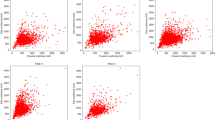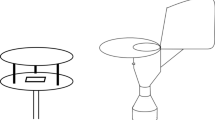Abstract
The development of a simple and automatic pollen measurement methodology is required to manage allergic problems caused by airborne pollen. We developed a device and algorithm to automatically monitor airborne pollen by using basic laser optics technology. The device measures the sideward and forward scattering intensities of laser light from each particle. Because this device provides detailed temporal variation in the pollen concentration, the dispersal dynamics of airborne pollen can be effectively analyzed. We compared the pollen counts obtained with the automated method and standard Hirst-type method. Scatter-plot graphs were constructed of the forward and sideward scattering intensities of the observed particles. An extract window methodology was used to estimate the concentrations of the major allergenic pollens. The extract window parameters were obtained for major types of allergenic pollen. The results suggest the possibility of developing a device for monitoring several types of airborne pollen simultaneously. We determined the standard extract window to be used for estimating the concentration of all types of airborne pollen together. A field experiment was performed to evaluate the automated monitoring system with the standard extract window. The estimated temporal variation pattern of the total airborne pollen concentration agreed well with the observed temporal variation pattern for the whole pollen season. The pollen monitor was able to estimate the overall features of seasonal changes in the total airborne pollen concentration.





Similar content being viewed by others
References
Aronne, G., Cavuoto, D., & Eduardo, P. (2001). Classification and counting of fluorescent pollen using an image analysis system. Biotechnic and Histochemistry, 76, 35–40.
Bechar, A., Gan-Mor, S., Vaknin, Y., Shemulevich, I., Ronen, B., & Eisikowitch, D. (1997). An image-analysis technique for accurate counting of pollen on stigmas. New Phytologist, 137, 639–643.
Bennett, K. D. (1990). Pollen counting on a pocket computer. New Phytologist, 114, 275–280.
Chen, C., Hendriks, E. A., Duin, R. P. W., Reiber, J. H. C., Hiemstra, P. S., de Weger, L. A., et al. (2006). Feasibility study on automated recognition of allergenic pollen: Grass, birch and mugwort. Aerobiologia, 22, 275–284.
Crouzy, B., Stella, M., Konzelmann, T., Calpini, B., & Clot, B. (2016). All-optical automatic pollen identification: Towards an operational system. Atmospheric Environment, 140, 202–212.
Galan, C., Smith, M., Thibaudon, M., Frenguelli, G., Oteros, J., Gehrig, R., Berger, U., Clot, B., Brandao, R., EAS QC Working Group. (2014). Pollen monitoring: Minimum requirements and reproducibility of analysis. Aerobiologia, 30, 385–395.
Gottardini, E., Rossi, S., Cristofolini, F., & Benedetti, L. (2007). Use of Fourier transform infrared (FT-IR) spectroscopy as a tool for pollen identification. Aerobiologia, 23, 211–219.
Harder, L. D. (1990). Pollen removal by bumblebees and its implications for pollen dispersal. Ecology, 71, 1110–1125.
Healy, D. A., O’Connor, D. J., Burke, A. M., & Sodeau, J. R. (2012). A laboratory assessment of the waveband integrated bioaerosol sensor (WIBS-4) using individual samples of pollen and fungal spore material. Atmospheric Environment, 60, 534–543.
Hinz, K. P., Greweling, M., Drews, F., & Spengler, B. (1999). Data processing in on-line laser mass spectrometry of inorganic, organic, or biological airborne particles. Journal of the American Society for Mass Spectrometry, 10, 648–660.
Kawashima, S., & Takahashi, Y. (1995). Modelling and simulation of mesoscale dispersion processes for airborne cedar pollen. Grana, 34, 142–150.
Kawashima, S., & Takahashi, Y. (1999). An improved simulation of mesoscale dispersion of airborne cedar pollen using a flowering-time map. Grana, 38, 316–324.
Kawashima, S., Clot, B., Fujita, T., Takahashi, Y., & Nakamura, K. (2007). An algorithm and a device for counting airborne pollen automatically using laser optics. Atmospheric Environment, 41, 7987–7993.
Kiselev, D., Bonacina, L., & Wolf, J.-P. (2011). Individual bioaerosol particle discrimination by multi-photon excited fluorescence. Optics Express, 19, 24516–24521.
Kiselev, D., Bonacina, L., & Wolf, J.-P. (2013). A flash-lamp based device for fluorescence detection and identification of individual pollen grains. Review of Scientific Instruments, 84, 033302.
Landsmeer, S. H., Hendriks, E. A., De Weger, L. A., Reiber, J. H. C., & Stoel, B. C. (2009). Detection of pollen grains in multifocal optical microscopy images of air samples. Microscopy Research and Technique, 72, 424–430.
Longhi, S., Cristofori, A., Gatto, P., Cristofolini, F., Grando, M. S., & Gottardini, E. (2009). Biomolecular identification of allergenic pollen: A new perspective for aerobiological monitoring? Annals of Allergy, Asthma & Immunology, 103, 508–514.
Marcos, J. V., Nava, R., Cristóbal, G., Redondo, R., Escalante-Ramírez, B., Bueno, G., et al. (2015). Automated pollen identification using microscopic imaging and texture analysis. Micron, 68, 36–46.
Mishchenko, M. I., Hovenier, J. W., & Travis, L. D. (2000). Light scattering by nonspherical particles: Theory, measurements, and applications. San Diego: Academic Press.
Mitsumoto, K., Yabusaki, K., Kobayashi, K., & Aoyagi, H. (2010). Development of a novel real-time pollen-sorting counter using species-specific pollen autofluorescence. Aerobiologia, 26, 99–111.
O’Connor, D. J., Healy, D. A., & Sodeau, J. R. (2013). The on-line detection of biological particle emissions from selected agricultural materials using the WIBS-4 (waveband integrated bioaerosol sensor) technique. Atmospheric Environment, 80, 415–425.
O’Connor, D. J., Healy, D. A., Hellebust, S., Buters, J. T. M., & Sodeau, J. R. (2014). Using the WIBS-4 (waveband integrated bioaerosol sensor) technique for the on-line detection of pollen grains. Aerosol Science and Technology, 48, 341–349.
Oteros, J., Pusch, G., Weichenmeier, I., Heimann, U., Möller, R., Röseler, S., et al. (2015). Automatic and online pollen monitoring. International Archives of Allergy and Immunology, 167, 158–166.
Ranzato, M., Taylor, P. E., House, J. M., Flagan, R. C., LeCun, Y., & Perona, P. (2007). Automatic recognition of biological particles in microscopic images. Pattern Recognition Letters, 28, 31–39.
Rittenour, W. R., Hamilton, R. G., Beezhold, D. H., & Green, B. J. (2012). Immunologic, spectrophotometric and nucleic acid based methods for the detection and quantification of airborne pollen. Journal of Immunological Methods, 383, 47–53.
Stanley, W. R., Kaye, P. H., Foot, V. E., Barrington, S. J., Gallagher, M., & Gabey, A. (2011). Continuous bioaerosol monitoring in a tropical environment using a UV fluorescence particle spectrometer. Atmospheric Science Letters, 12, 195–199.
Takahashi, Y., Aoyama, M., Abe, E., Aita, T., Kawashima, S., Ohta, N., et al. (2008). Development of electron spin resonance radical immunoassay for measurement of airborne orchard grass (Dactylis glomerata) pollen antigens. Aerobiologia, 24, 53–59.
Wagner, J., & Macher, J. (2012). Automated spore measurements using microscopy, image analysis, and peak recognition of near-monodisperse aerosols. Aerosol Science and Technology, 46, 862–873.
Xu, R. (2000). Particle characterization: Light-scattering methods. Dordrecht: Kluwer Academic Publishers.
Young, H. J., & Stanton, M. L. (1990). Influences of floral variation on pollen removal and seed production in wild radish. Ecology, 71, 536–547.
Acknowledgements
We thank Dr. Seiichiro Yonemura of the National Institute for Agro-Environmental Sciences for the greatly inspiring discussions. In addition, we thank Ms. Yuriko Arakawa of the secretary section at the Graduate School of Agriculture, Kyoto University, for performing numerous tasks on our behalf. This research did not receive any specific grant from funding agencies in the public, commercial, or nonprofit sectors.
Author information
Authors and Affiliations
Corresponding author
Rights and permissions
About this article
Cite this article
Kawashima, S., Thibaudon, M., Matsuda, S. et al. Automated pollen monitoring system using laser optics for observing seasonal changes in the concentration of total airborne pollen. Aerobiologia 33, 351–362 (2017). https://doi.org/10.1007/s10453-017-9474-6
Received:
Accepted:
Published:
Issue Date:
DOI: https://doi.org/10.1007/s10453-017-9474-6




